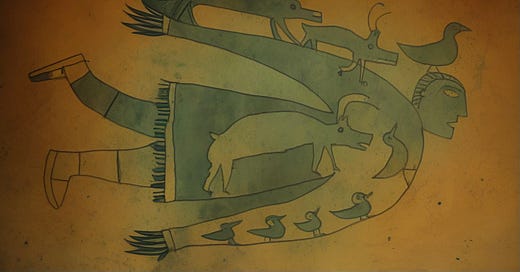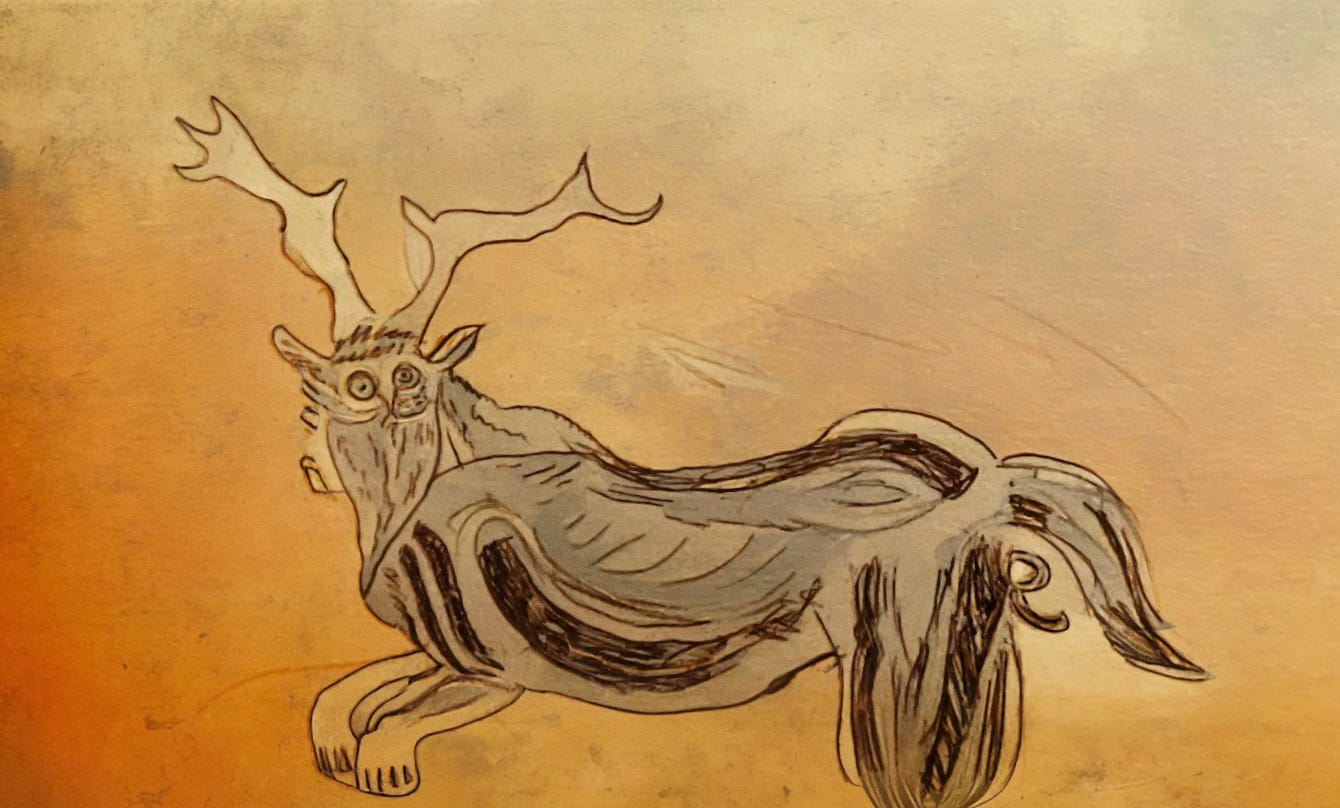Did you ever lie on the ground looking up at the clouds? I love watching them, especially at night, when they tower in the sky: ever-changing and ever-shifting. You can make out faces, forms and shapes, wolves morph into dragons and the like.
This theme of shifting forms is something dear to the Celtic spirit. The works attributed to the bard, Taliesin, are filled with such imagery. His collection of poems provides us with the back-drop for his strange tale. Originally called, Gwion, the bard appears in the court of Ceridwen. She’s a creator goddess who reflects many aspects of the Cailleach. Ceridwen sired two children: Creiwy, the most beautiful girl in the land and Avagddu, the ugliest boy. As recompense for Avagddu’s ugliness, Ceridwen created a potion of inspiration to bestow him wisdom. Gwion’s task was to tend the flames beneath the huge, black cauldron, helped by an old man called Morda. Scalded by some drips from the potion, Gwion licked where he felt burned, and inadvertently tasted the brew. His mind was suddenly filled with great knowledge.
The first thing that came to mind was self-preservation. The lad fled, with Ceridwen hot on his heels. They morphed through various guises until, hiding as a seed of grain on a barn floor, Ceridwen, herself changed into a black hen and gobbled him up. For nine months the seed gestated in her womb until a child was born. This was Taliesin, the great bard.
Throughout the poems attributed to him, themes of shape-changing abound. But this concept isn’t limited to the works of Taliesin. The corpus of Celtic literature is filled with similar ideas. The goddess Morrígan is known to appear in crow form, but others too. When she sought to frustrate Cú Chulainn she became an eel. Etain, the love of the god, Midir, was changed into a fly by a jealous rival. After wandering aimlessly throughout Ireland for many years, Etain finally tumbled into a cup belonging to a chieftain’s wife, who gulped her down. Nine months later, Etain was reborn. She later returned to Midir’s side and they transformed into swans.
Another character, Tuan mac Carell, revealed to Christian monks his great age, and told them that he’d witnessed the invasions of Ireland. He revealed how he fell asleep, decrepit and wasted with age, but changed into a deer. Then he witnessed the coming of the Sons of Nemed, before age claimed him again. This time he changed into a wild boar. Again he related the tales of other invaders of Ireland, the Fir Bolg, and once more age bestowed upon him another transformation, this time into an eagle. He witnessed the comings of the Tuatha De Danaan, followed by the Sons of Miled. He witnessed their wars, and how the Tuatha De Danaan went to live amongst the hollow hills. This time he became a salmon until netted by a fisherman. Brought into the house of Carell, and eaten by the chief’s wife, nine months later he was reborn as Tuan mac Carell.
Similar examples exist in ancient Welsh literature too – we are barely skimming the surface of such references! Without a doubt, the bards and storytellers liked these tales, but this theme was more than a literary prop. These are constant refrains: metamorphosis, nothing being permanent, all things subject to change. In ways it’s a very modern philosophy, and so very ancient.
Shamanic systems are filled with practical, psychic and mythic transformation. Processes like ecstatic trance and dream journeying involve change. There are numerous accounts of shamanic transformations into animal form, bird form etc. This belief process is very ancient and continues to this day. In rituals a shaman might clothe themselves in feathered cloaks, and in trance emulate flight to journey inner worlds. Accessing the realms of spirits to recover souls and battle the source of illness. Birds are common, but, other animals are represented by shamanic costume too – including reindeer and wolves.
Snorri Sturluson reveals that Odin would fall into a deathlike trance, then assume the shape of beast, bird, fish or dragon, in whose guise he’d journey to distant lands in the blink of an eye.
The aforementioned Hanes Taliesin is filled with verse, in which the fluidity of form is both profound and evocative.
Another time I was enchanted:
I was a kingfisher, I was a young salmon
I was a hound, and I was a hind
I was a buck on the mountain
I was a butt, and I was a spade
I was a hatchet in the hand
I was the pin of the tongs
For a year and a half
I was a light-speckled cock
Cackling over hens
I was the stallion of a stud
I was the bull of a homestead
I was the miller’s bolter
The ground corn of the farmer
I was a grain in the furrow’s womb
I grew up on the hill
He who sowed, reaped me,
into the kiln-pipe he drove me
He rubbed me out of hand
While he was scorching me,
There he received a hen
Ruddy clawed, with a divided comb
I rested nine nights
In her womb a child
The ancient Irish annals tell of how when the Milesians arrived on their shores, their chief bard, Amairgin recited this verse:
I, the wind at sea
I, the rolling billow
I, the roar of Ocean
I, the seven cohorts
I, the ox upholding
I, the rock borne osprey
I, the flash of sunlight
I, the ray in mazes
I, the rushing wild boar
I, the river salmon
I, the lake over plains
I, the strength of song
In these themes of change and transformation*, two threads emerge. The first is that of the shamanic** themed change, the practice of ceremony and ritual. This appears in both myth and the poems of the bards. It’s evident that these were important subjects.
The second ties into the first. It’s the idea that the boundaries between worlds and forms was pretty seamless. As a shaman, the voyager travelled to the lands of the dead while they are alive. These methods of accessing inner worlds have been used for thousands of years. It’s not so easy to disregard something so ancient. And let’s face it, if these techniques of ecstatic healing didn’t work in some way, they wouldn’t have endured throughout the ages.
As we can see, there are examples here of visualisation. In fact, the Bard could be seen as a receptacle of this process, reinforcing imagery through verse. Modern scientific studies have proven the positive effects of visualisation in healing techniques. Methods such as kinesthetic imagery*** have been utilised by athletes to enhance performance. For those suffering illness, the conjuring to mind of positive imagery can be beneficial. For example, injecting colour into darkness, or imaging cleaning a diseased area. These techniques work on a physical level. Why? Well, as every shaman should know, matter is mind and mind is matter. At a base level, our mind controls everything about us. We’re not composed of separate units that function on their own, like separate states. They are part of a whole.
I remember as a child of eight or nine, laying in bed with an illness. For some reason I saw my body as a factory, filled with pipes and machines. I saw that some of the pipes were clogged with foul liquid and needed cleaning. I imagined little workers inside me flushing the pipes with steam. I remember feeling that something actually shifted and the next day I felt better. I was too young to understand the process, but it always stayed with me.
We have the power to alter our states of being, as a shaman does. In these heightened head-spaces much can be accomplished.
There’s another level to view the mythic transformations described here. Classical writers suggest that the Celtic Druids believed in reincarnation. There does seem to have been a strong belief in the immortal soul, whose form altered, changed and travelled different worlds. This flowing of forms after death (Transubstantiation) is evident in the passages where characters metamorphoses until being reborn in human form.
Confusion arises because the Celts also practiced ancestor worship and believed that, at certain points of the year, the realm of living and dead could be traversed. They also held the belief that the dead would dwell in the Land of Youth. Other versions, like the House of Donn, are gloomier and more like the Hades of the Greeks. But let’s remember, theirs was no regime of doctrine, but a plethora of ideas and beliefs. It could be that some allied themselves philosophically to different concepts of the afterlife. However, it’s obvious that there’s much in the literature to point to a belief in transubstantiation.
Notes:
*Another incredible piece of bardic prose is Ovid’s, Metamorphoses. Though Grecian, it’s epic in its extant, and well worth a read. The thread of change runs throughout the text and its imagery is extremely visual. It recounts a staggering array of transformations that occur through a selection of Grecian myths.
**By ‘shamanic’ – I use the term to reflect a host of practices and practitioners, both past and present, who utilise similar methods globally.
*** In this technique, subjects visualise how movement feels without the accompanying physical activity.
References:
Shamanism: Archaic Techniques of Ecstasy – Mircea Eliade
Hanes Taliesin – Trans. J. Gwenogoryn Evans
Celtic Mythology and Folklore – Patricia Monaghan
Bards of the Gael and Gall – George Sigerson
Why Woo-woo works – David R. Hamilton Ph.D






